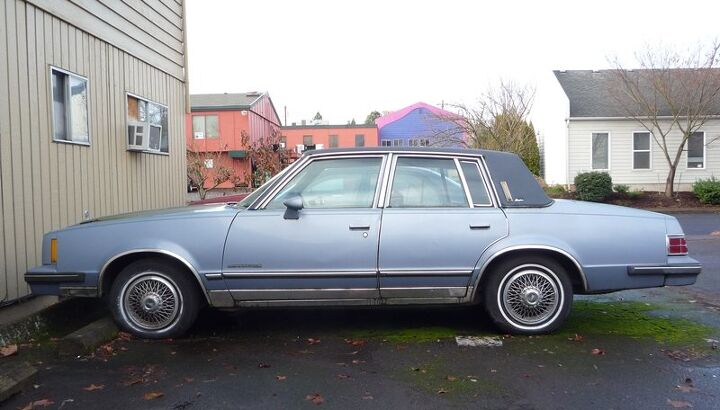Curbside Classic: GM's Deadly Sin #8 – 1984 Pontiac Bonneville Brougham

Yes, when it comes to GM, there were definitely more than seven deadly sins. Actually, there were tens of millions of them. And while this is perhaps one of the less conspicuous and pernicious ones (I didn’t label it as such until I put up the first picture and had to rewrite the title), it is one nevertheless. And what is the sin this innocuous sedan embodies? Thou shalt not take thy godly names in vain.
Undoubtedly, there are worse sins GM has committed. But no one destroyed names better and faster than the General. Nevertheless, slapping on the name of what once was a one of GM’s most exulted cars that embodied the golden decade of Pontiac in the sixties on this crappy little mid-sized corporate sedan typified GM’s death spiral of the eighties. It perfectly encapsulates the loss of direction Pontiac experienced during the mothership’s worst decade ever. How fast the mighty fall, given how twenty years earlier the ’63 Bonneville was the style leader of the whole industry.
Chalk it all up to the price of oil, both high and low, the fickle American consumer, and a loss of direction and styling inspiration. When GM successfully downsized its full-sized cars in 1977, the new Pontiacs utterly failed to ignite the buyers unlike its corporate siblings. Perhaps the restrained and more formal look of the boxier ’77s just didn’t work with Pontiac’s exuberant image, but the new Pontiacs really were rather lackluster. Anyway, big coupes were out, and the sedans were barely indistinguishable from its corporate siblings. The days when Pontiac could break away from the pack with a bold front end were over, and so was Pontiac.
With the new B-bodies lagging, and a nasty second energy crisis spiking gas to breathtaking heights, Pontiac made a crap-shoot move: kill the big cars entirely. Reminiscent of Chrysler’s disastrous 1962 great shrinkage, Pontiac’s move was at least based on the price of gas rather than a rumor. But it turned out almost as bad anyway, since oil prices are about an equally unreliable planning tool. At least in the eighties, as oil quickly began the most dramatic drop ever.
So for 1982, Pontiac slapped the Bonneville name, plus the enigmatic Model G surname, on its LeMans mid-sized sedan. Well, that didn’t turn out so well, and Pontiac probably saw it coming before it even played itself out, because by 1983 the Canadian-sourced full-sized Parisienne was back in the showrooms. The one-year gap to find a replacement for the old Bonnie was just a bit longer than it took Dodge to cobble together the full-size 880 in 1962. We covered the Parisienne story here.
This version of the downsized B-bodies came along a couple of years after the disastrous Aer0-back sedans that Buick and Olds was inflicted with. Pontiac was spared that sin, and the ’78 LeMans shared a slightly modified “normal” sedan body with the Chevy Malibu. But the quickly revised traditional four doors for Buick and Olds, which heavily aped the 1975 Seville, found its way across the board.
It certainly was innocuous enough; too much so, with the identity same problem as GM’s FWD clone-mobiles of the era. It takes a practiced eye to tell this car apart from its Buick, Olds and Malibu stablemates. Who cared anymore anyway? They were all the same.
Given that the bigger GM B-bodies of the times were quite successful with redeeming qualities, its disappointing that the downsized A-bodies were decidedly more modest in their ambitions. Some faulted me for giving the 1979 Malibu Coupe a rather glowing CC retrospective. I admit that my feelings were more about the potential of these cars than the the real thing. They were sized right, without the excessive overhangs and obesity of their predecessors, and had the potential benefit of GM’s engine and suspension prowess. Unfortunately, that potential was rarely fulfilled.
Most of them came with the enfeebled 231 CID (3.8 L) Buick V6, which was choked to 110 hp. The Chevy 305 packing 150 hp gave the closest approximation of performance, given the fairly light weight. We’ll just avoid any mention of the Olds diesel V8. The Buick V6 and the Chevy V8 were fundamentally solid lumps, but quality issues were so rampant at GM during the eighties that even engines made for decades were suddenly suspect. The downsized THMD 200 automatics that backed them were well beyond suspect.
The general feel of the cars, especially by the mid eighties, was just deadly. As in deadly boring, or deadly unreliable, or at best, mortally modest. The fact that GM could screw up such a fundamentally simple car, with fairly clean lines, helps explain its plummeting market share during their production years. Taking the Bonneville name along for the ride into the muck of mediocrity was the final straw. Pontiac was finished, except for its protracted death march in the years to come as the Wal Mart BMW.

More by Paul Niedermeyer
Latest Car Reviews
Read moreLatest Product Reviews
Read moreRecent Comments
- Theflyersfan My dad had a 1998 C280 that was rock solid reliable until around 80,000 miles and then it wasn't. Corey might develop a slight right eyelid twitch right about now, but it started with a sunroof that leaked. And the water likely damaged some electric components because soon after the leaks developed, the sunroof stopped working. And then the electrical gremlins took hold. Displays that flickered at times, lights that sometimes decided illumination was for wimps so stayed home, and then the single wiper issue. That thing decided to eat motors. He loved that car but knew when to fold the hand. So he bought a lightly used, off lease E-class. Had that for less than two years before he was ready to leave it in South Philly, keys in the ignition, doors unlocked, and a "Take it please" sign on the windshield. He won't touch another Benz now.
- Detlump A lot of people buy SUVs because they're easier to get in and out of. After decades of longer, lower, wider it was refreshing to have easier ingress/egress offered by an SUV.Ironically, the ease of getting in and out of my Highlander is very similar to my 56 Cadillac.
- Redapple2 LP Michigan. Long straights. A long sweeper. 2 chicanes. 4 hard turns. Lenghts of each element are different but similar to LeMans.
- Teddyc73 Doesn't matter, out of control Democrats will still do everything they can to force us to drive them.
- Teddyc73 Look at that dreary lifeless color scheme. The dull grey and black wheels and trim is infecting the auto world like a disease. Americans are living in grey houses with grey interiors driving look a like boring grey cars with black interiors and working in grey buildings with grey interiors. America is turning into a living black and white movie.







































Comments
Join the conversation
Interesting to note that the 1982 downsized Bonny sold 80513 sedans and wagons which was a considerable jump over it's 81 Lemans predecessor. That number raised to 83889 and held close for 1984. Compare the 82 Grand Fury which was also a downsized replacement for the old larger 1981 model at 18111 or 15739 for 1983. Dodge faired a little better at 23146 for it's downsized Dimplomat and Mercury sold 56950 Cougar sedans and wagons in 1982 and 67358 downsized Marquis sedans and wagons for 1983. Only the Cutlass sedan, Malibu and Granada coupe, sedan and wagon managed to outsell the new downsized Bonneville which again doesn't really derserve it's deadly sin moniker.
Here's the thing... after owning a newer GM car, I would trust a decently kept Bonneville Brougham to outlast a brand new GM car today (or at least my willingness to drop $3k a month to keep it running).